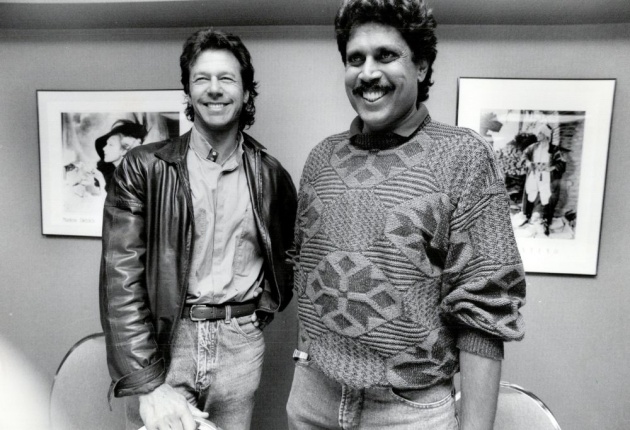Which players from the from the late-'70s and early-'80s line-ups of the two countries, would make it into a combined XI to beat the world? Here's one team

Just the other day, as I watched the Pakistan Test captain hoist his team across his broad shoulders and calmly carry them over the victory line for the umpteenth time, I commented on a popular social media site, "Every time I see Misbah-ul-Haq play I think to myself: now there's another reason why Partition was a bad idea." It raised a few chuckles and some friendly eye-rolling from Pakistani friends about Indian imperialism. The comment may have seemed baffling to younger generations of subcontinentals, who take the attitude of "anyone but Pakistan" if they are Indian and vice versa across the border.
Yet I remember a time in the 1970s when some of us used to fantasise about a joint Indo-Pak XI that could have taken on the best in the world and possibly triumphed. It was an era in which it was common to put our support behind Pakistan once India crashed out of international field hockey tournaments: let the gold medal stay in the region, we thought, rather than have it go to the Germans or Dutch or other rising hockey powers.
Here I would like to put my dream India-Pakistan XI down on paper. For starters, let us limit the period of selection to 1977-1983, as matters get too complicated with a longer time span. I would open with Majid Khan and Sunil Gavaskar. They were both tremendous players of the best fast bowlers of their time, and Majid's attacking instincts would be a perfect foil to Gavaskar's more solid approach. I flirted with the idea of a left-right opening combination, but the sole left-hand possibility from that era, Sadiq Mohammad, just doesn't have a record that displaces Gavaskar or Majid.
The crucial No. 3 position presents a real headache for at least two reasons: first, there is a lot of talent to pick from, and second, during this period quite a few batsmen rotated through that spot. It came down to choosing among Zaheer Abbas, Mohinder Amarnath and Dilip Vengsarkar. All three averaged in the low-to-mid-40s, a respectable figure for that era, especially given the quality of fast bowling. Both Vengsarkar and Abbas had a less than stellar record when travelling to Australia and the West Indies. Amarnath, on the other hand, seemed to thrive against the best fast bowling and his performance in the West Indies and against a rampaging Imran Khan in Pakistan stand among the all-time great displays of fighting fire with fire. So with some regret at having to leave out two of the most stylish and elegant batsmen in Abbas and Vengsarkar, I am going with the doughty Amarnath at one-drop.
Two completely contrasting characters - GR Viswanath and Javed Miandad - anchor my middle order. While Vishy was a purist's delight - all wrists and timing encased in copybook technique - Javed, with his open stance and stump-covering shuffle was more of a pugnacious and relentless accumulator. If Vishy was the sportsman who invariably walked if he nicked one, Javed was the street-smart rogue who often played with - rather than by - the rules.
For No. 6, I am going with that swashbuckling left-hand libero Wasim Raja. His statistics may not hold up as well as those of some others but Raja was brilliant when it mattered. Just have a look at his numbers - including the number of sixes he hit - on that brutal tour to the West Indies in 1977, when the home team's pace attack was at its relentless best. Raja's electric fielding and his brilliant ability to turn a match with his spin bowling add to an already strong case.

The next two spots belong to two of the greatest allrounders the game has ever seen: Imran Khan and Kapil Dev. The prospect of them in their pomp opening the bowling, and then returning to the crease as batsmen when their opponents had struggled through the top order, is just mind-blowing. Their presence elevates this team to genuine world-beaters, no question about that.
For the wicketkeeper's spot, Syed Kirmani just edges out Wasim Bari. They were both brilliant but Kiri's slightly superior batting (all too often his runs were made after the top order had collapsed) wins the day.
Picking the final two bowlers to complete the XI was tougher than I thought. Sarfraz Nawaz eventually emerged as the best of the available options to come on as first change after Imran and Kapil had made the early inroads. Which leaves the spinner (in my fantasy this team is playing outside the subcontinent, so three pacers and one spinner is the way to go). While someone like Bishan Bedi would have been an obvious choice, he was on the wane and by 1979 his career ended, as had BS Chandrasekhar's. Iqbal Qasim had his moments but not enough of them to pip the other obvious contender: Abdul Qadir. While like many a spinner Qadir's numbers on the road are not as impressive as those at home, he was a match-winner and could be a real handful when his team put runs on the board.
Six Pakistanis and five Indians - not an unfair distribution if you take into account Pakistan have the better record in bilateral matches and outdistance India in winning abroad.
Which brings us to the final question: who will be the captain? With "characters" like Javed, Sarfraz and Qadir and at least four former captains in the side, the man in charge has to have a commanding personality, and be adept at herding cats - of the wild variety. To me the choice is obvious: Imran. If there was anyone who could meld this extraordinary wealth of talent and personalities into a world-beating team, it would have to be him.



